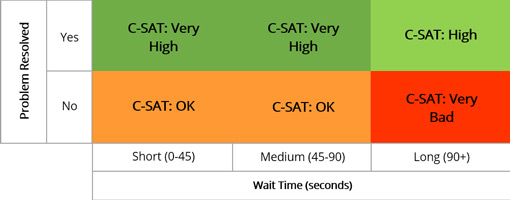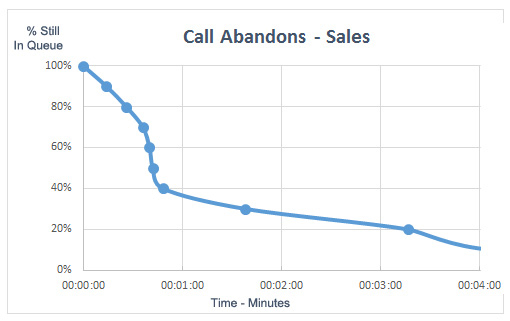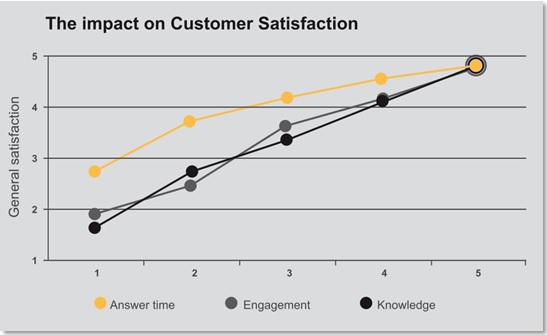Although contact centres spend much energy reducing queue times, it has been said that it does not have much of an effect on customer satisfaction.
So, we decided to determine if this was indeed the case, whilst also asking our readers and industry experts for their thoughts.
The short answer
If you resolve the problem, there is not a big correlation between queue time and customer satisfaction.

Instead, as you can see in the table above, lack of success in having their query resolved has a much greater negative impact upon customer satisfaction.
However, it is not just success that has a more significant impact on customer satisfaction than queue time, as the authors of the research paper “Waiting in Vain: Managing Time and Customer Satisfaction at Call Centres” discovered.
In the piece, the writers noted that “time satisfaction might be influenced by how satisfying the whole service experience is apprehended by the customer.”
This is because “customers that put a high value on the service provided are prone to wait more. Hence, the influence of actual time was expected to be less important for satisfaction with the waiting time the longer the customer waited.
“The findings suggest that in order to keep customers satisfied with the time, managers and decision makers should concentrate on empowering agents to give an informative satisfactory answer and top of the line service. Contradictory to ‘common sense’ this is even more important as queue time increases.
“In other words, customer satisfaction with time can be achieved by just giving the customer more quality time.”
So, empowering agents with greater time on the call does seem to improve customer satisfaction, even if you do increase queue time.
Long queues mean that callers will abandon
So, can we just leave customers in the queue? The problem is that you will increase the number of abandons.
Sure, some will just phone back straight away, but your inbound sales team will lose over 60% of customers if you do not answer the phone in less than a minute, according to the graph below.

So, if you do want to extend queue time to increase agent empowerment, it is important to create and check a call abandon graph like the one above and aim for a high service level before the numbers of those leaving the queue start to fall dramatically.
Follow the link for information on: How to Bring Down Your Call-Abandon Rates
So what advice would our readers and experts give? And have they noticed any correlation?
Agent empowerment and knowledge have greater correlation than queue time
The fact that answering 80% of calls in 20 seconds is still the key target in the contact centre shows that many people still perceive queue time to be directly linked with customer satisfaction.
When we looked at half a million customer satisfaction surveys, speed of answer did have an impact on C-SAT, but customers very dissatisfied with how long it took to talk to an advisor still went on to score an average overall satisfaction.
Customers very dissatisfied with advisor engagement and knowledge, however, went on to score both C-SAT and NPS at rock bottom levels.

Thanks to Mark Jones at Bright
Customer satisfaction may not change when queue time is lower than 45 seconds
Typically, a 45-second expected wait time won’t increase call dissatisfaction as long as resolution is achieved.
This can be even longer if the call is about technical support and not just sales related.
But most customers will complain about wait times if they don’t get resolution, and you will see the same principle when it comes to offshore/non-native speakers.
Zero effect if resolution achieved; major dissatisfaction if resolution not achieved.
Thanks to Peter Massey
Don’t let service level drop below 60%
When service levels dropped below 60% (i.e. only 60% of customers had their call answered within 30 seconds), then customer satisfaction started to decrease rapidly.
The lower the service level dropped, the lower the C-SAT, following the pattern of an exponential decline as opposed to a linear decline. When the service level reached 30%, C-SAT had reached rock bottom.
If an organisation can link C-SAT and revenue, then I believe there is a strong business case to justify achieving a ‘tolerable’ call wait time.
Thanks to Lee Mostari
Queue times of over 90 seconds are likely to negatively impact customer satisfaction
In excess of 90 seconds is usually the point at which C-SAT scores start to be negatively impacted, but I think it’s very difficult to be scientific about this as too many factors influence customer perception.
What is definitely correct, however, is that a longer than 90-second wait that is immediately followed by superior listening skills and first contact resolution will in most cases receive an excellent Net Promoter Score and Customer Effort Score.
Thanks to Dan Cuthbert
Be wary of assumptions – check your data first
If you can see wait time, query type and C-SAT by record then you will be able to analyse existing data to find out. If not, be wary of assumptions about long vs typical wait times, as long wait times are likely to be linked with exceptional call demand, breakage, etc., not like for like.
When you do have long wait times, what is the data saying about when customers abandon? This will be a good indication of how long your customers are prepared to wait.
Also, focus on data for answer rates. You may forget how long you waited, but you won’t forget that you got so frustrated waiting that you gave up and had to call a second time.
Thanks to Ben Lappin
Conclusion
The general consensus seems to be that customer satisfaction will not be affected if a resolution to the customer’s query is found and the queue time is less than 90 seconds.
However, that 90-second figure could change depending on which sector your contact centre is in, with customers generally willing to wait longer for technical support than for a sales call.
Also, the combination of a long queue time and the customer not having their problem resolved will lead to very low customer satisfaction, much more so than if the queue time is between 0 and 45 seconds.
So, is it worth increasing queue time to greater empower your advisors? That depends, but you must first check your data and focus on your answer rates to see how long your customers are willing to wait.
Have you seen a correlation between queue times and customer satisfaction?
Please put your thoughts and responses in an email to Call Centre Helper.
Author: Robyn Coppell
Published On: 10th May 2017 - Last modified: 23rd Jul 2024
Read more about - Customer Service Strategy, Abandoned Calls, Average Speed of Answer (ASA), Bright, Customer Satisfaction (CSAT), Editor's Picks, Employee Engagement, Peter Massey, Queues, Service Level




































